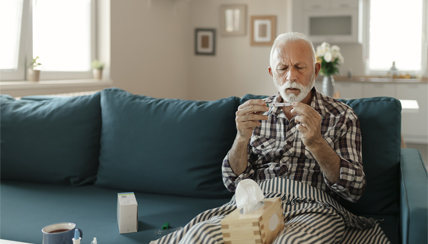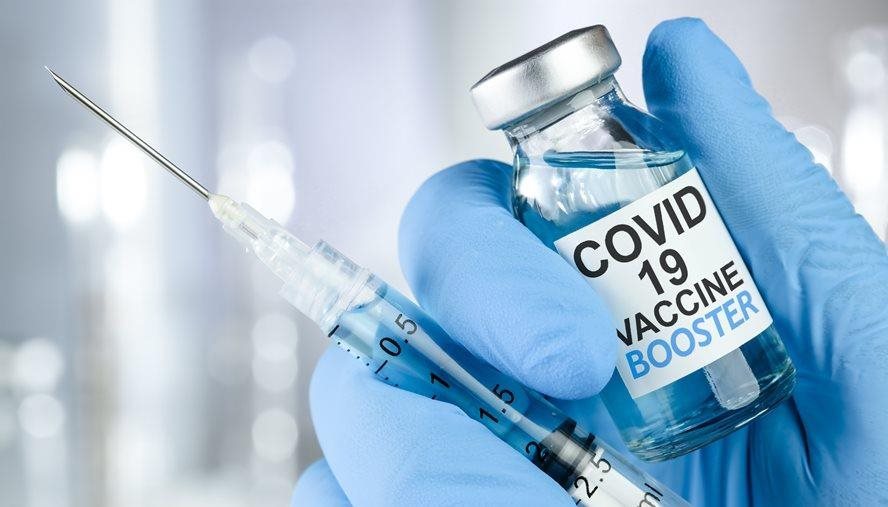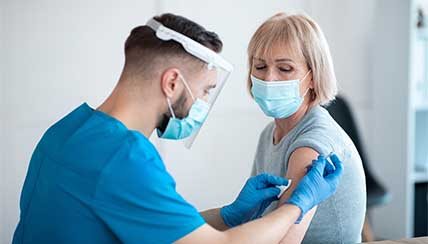COVID-19 (Coronavirus) & Your Lungs
 COVID-19 is a respiratory virus and disease. It is spread by small droplets from coughs and sneezes and from touching infected surfaces. As of posting date, we know that at least 80 percent of people who are infected with the virus will have anywhere from no symptoms to mild to moderate flu-like symptoms, including a fever and cough. The remaining 20 percent may develop more severe cases of coronavirus may develop pneumonia or severe acute respiratory syndrome.
COVID-19 is a respiratory virus and disease. It is spread by small droplets from coughs and sneezes and from touching infected surfaces. As of posting date, we know that at least 80 percent of people who are infected with the virus will have anywhere from no symptoms to mild to moderate flu-like symptoms, including a fever and cough. The remaining 20 percent may develop more severe cases of coronavirus may develop pneumonia or severe acute respiratory syndrome.
How Does COVID-19 Affect the Lungs?
Coronavirus can affect the upper respiratory system (nose, sinuses and throat) with flu-like symptoms, the lower respiratory system (airways and lungs) by causing cough with or without mucous and difficulty breathing. When COVID-19 is severe it can bring on pneumonia or acute respiratory distress syndrome (ARDS).
Upper Respiratory Infection
Common symptoms of respiratory infections in the nose, sinuses and throat include nasal congestion, runny nose, sore throat, sneezing, achy muscles and headache. Coronavirus upper respiratory infection symptoms also may include cough, diarrhea, fever, shortness of breath, loss of smell and /or taste and tiredness.
Lower Respiratory Infection
Common symptoms of COVID-19 respiratory infections in the airways and lungs may include severe cough that produces mucous, shortness of breath, chest tightness and wheezing when you exhale.
When Coronavirus is Severe
If COVID-19 goes deep into the lungs, it can cause pneumonia. Pneumonia is a concern for older people because they have reduced lung capacity, require longer recover time and have age-weakened immune systems.
Pneumonia that is caused by coronavirus may be more severe, affect many parts of the lungs, and cause shock, organ damage, abnormal blood clotting, acute respiratory distress syndrome and deteriorating health.
How Pneumonia Affects the Lungs
When healthy lungs inhale, the lungs and their 480 million tiny air sacs (alveoli) fill with oxygen. These little air sacs get rid of carbon dioxide when you exhale and pass oxygen into the blood vessels.
Pneumonia causes the air sacs to become infected and inflamed. This causes fluid and inflammatory cells to build up in the lungs and prevents oxygen from getting through, causing severe breathing difficulties and lack of oxygen in the blood.
Severe cases of COVID-19-related pneumonia are treated in the hospital.
Risk Factors for Developing Pneumonia from COVID-19
- Diabetes
- Hypertension
- Chronic heart
- Chronic lung disease
- Immune suppressed conditions
- Being elderly (increasing age)
- Obesity
Symptoms of Severe Pneumonia Caused by Coronavirus
- Fever
- Fatigue
- Cough (with and without mucous)
- Loss of appetite
- Muscle aches
- Significant shortness of breath
- Chest pain (especially under the breastbone)
- Rapid breathing
- Sweats
- Headache
- Weakness
COVID-19 Pneumonia & Acute Respiratory Distress Syndrome
Acute respiratory distress syndrome (ARDS) is life threatening. It is an injury to the lungs caused by infection or trauma. ARDS causes fluid to leak into the lungs. This makes is extreme difficult to breathe and causes a significant lack of oxygen getting into the bloodstream. The lack of oxygen harms the brain, organs and body tissues.
Most people who develop ARDS are already inpatients in the hospital. Treatment includes oxygen therapy to ensure the blood and body have enough oxygen to function properly. This may include being placed on a mechanical ventilator to deliver oxygen support. Pain control and sedation are often used to prevent agitation and shortness of breath. Fluids are managed to prevent build up in the lungs. In extreme circumstances, an extracorporeal membrane oxygenation (ECMO) machine may be used to oxygenate the blood outside the body while the body fights the infection and repairs itself.
Post critical illness syndrome (PCIS) frequently follows critical illness from COVID-19. This can result in weakness, anxiety, post traumatic distress syndrome and chronic shortness of breath. Pulmonary rehabilitation is used as part of a treatment plan for PCIS to help ARDS patients recover strength.
This information has been reviewed and approved by Kenneth E. Lyn-Kew, MD (September 2020).
The information on our website is medically reviewed and accurate at the time of publication. Due to the changing nature of the COVID-19 pandemic, information may have since changed. CDC.gov and your state’s health department may offer additional guidance. |


